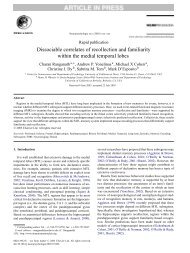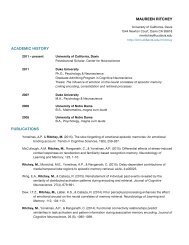CLINICAL EEG and NEUROSCIENCE - Dynamic Memory Lab
CLINICAL EEG and NEUROSCIENCE - Dynamic Memory Lab
CLINICAL EEG and NEUROSCIENCE - Dynamic Memory Lab
Create successful ePaper yourself
Turn your PDF publications into a flip-book with our unique Google optimized e-Paper software.
<strong>CLINICAL</strong> <strong>EEG</strong> <strong>and</strong> <strong>NEUROSCIENCE</strong> ©2007 VOL. 38 NO. 1et al 67 ), despite statistically indistinguishable MMSE scores(means 26.6 <strong>and</strong> 27.5 respectively).Summary: N400/P600 repetition effectsRecent work dissociating N400 <strong>and</strong> P600 repetitione ffects has found that MTL amnesics, whose ability toencode events into long term memory is compromised,show intact N400 but impaired P600 effects. This pattern offindings supports the notion that implicit <strong>and</strong> explicit retrievalprocesses are indexed by N400 <strong>and</strong> P600, respectively. InAD, both N400 <strong>and</strong> P600 repetition effects are severelydiminished. In MCI, the conjunction of reduced N400 <strong>and</strong>P600 repetition effects may be useful in identifying thoseindividuals at highest risk for subsequent conversion to A D .CONCLUSIONIntegrating across the ERP studies reviewed above,some useful generalizations can be made. The sensitivityof cognitive ERPs can be greatly increased by looking atmodulations of components, rather than expecting anabsence or near ablation of late components such as theP300, N400, <strong>and</strong> P600, all of which have multiple, distributedneural generators. Patients with a “pure” amnesticsyndrome usually have normal P300s (at least on the auditory“oddball” paradigm), but occasionally, abnormal P300shave been observed among those with more diffuse braininjuries. While memory was the only cognitive domain witha clinical deficit, the P300 abnormalities likely reflect subclinicalabnormalities in attention <strong>and</strong> working/immediatememory. Amnesic patients usually have normal N400effects, but an important exception is that of MCI “converters”with incipient AD. In contrast to the relatively normaleffects of word repetition on the N400, severe decrementsof the P600/LPC word repetition effect are present in wellcircumscribedamnesia.Patients with mild AD can usually generate reasonablysized P300 <strong>and</strong> N400 amplitudes, but quantitative analysesoften show subtle abnormalities beyond that attributableto aging. Across N400 experiments, the precise paradigmused appears to be very important <strong>and</strong> may lead todifferential sensitivity to amplitude or latency abnormalities.In mild AD, both N400 <strong>and</strong> P600 components demonstratea loss of normal word repetition effects. This suggests amore generalized failure of synaptic plasticity than inpatients with pure amnesia. Biomarkers of failed synapticplasticity should be of great value in AD, a disease thatsome leading investigators view as a primary disorder ofsynaptic function. 68,69 Studies of transgenic AD animal modelsoften find synaptic dysfunction prior to the appearanceof amyloid plaques or extensive neurofibrillary pathology.70,71 Clinico-neuropathological studies have found thatthe density of cortical presynaptic terminals is one of thestrongest predictors of dementia severity. 72ERPs may also provide a useful non-invasive tool forstaging the extent of AD pathology. In the mild to moderatestages of AD, the P300 <strong>and</strong> N400 potentials usually deterioratemarkedly, but with relative sparing of earlier sensorycomponents. 16 This is as one would predict based on thetypical staged progression of AD pathology. 73 Predilectionsites in early AD include the medial temporal lobe, otherlimbic areas, <strong>and</strong> multimodal association cortices withsparing of primary sensory areas. Unimodal associationcortex is involved in AD, but not as heavily as multimodalcortex. As more effective treatments emerge for AD, includingsome capable of reducing amyloid burden (e.g., A-βvaccination <strong>and</strong> γ-secretase inhibitors), biomarkers sensitiveto the reversal of cognitive processing deficits will be ofincreasing importance.ACKNOWLEDGMENTSSupported by National Institute on Aging (NIH grants#R01 AG18442 to J.M.O. <strong>and</strong> P50 AG05131 to J.R.T. )<strong>and</strong> the Department of Veterans A ff a i r s .REFERENCES1. Squire LR, Knowlton B, Musen G. The structure <strong>and</strong> organizationof memory. Annu Rev Psychol 1993; 44: 453-495.2. Olichney JM, Van Petten C, Paller K, Salmon DP, Iragui VJ,Kutas M. Word repetition in amnesia: electrophysiologicalmeasures of impaired <strong>and</strong> spared memory. Brain 2000; 123:1948-1963.3. Auchterlonie S, Phillips PA, Chertkow H. Behavioral <strong>and</strong>electrical brain measures of semantic priming in patientswith A l z h e i m e r’s disease: implications for access failure versusdeterioration hypotheses. Brain Cogn 2002; 48(2-3):2 6 4 - 2 6 7 .4. Donchin E, Coles MGH. Is the P300 component a manifestationof context updating? Behav Brain Sci 1988; 11 ( 3 ) :3 5 7 - 3 7 4 .5. Verleger, R. Event-related potentials <strong>and</strong> cognition: a critiqueof the context updating hypothesis <strong>and</strong> an alternative interpretationof P3. Behav Brain Sci 1988; 11: 343-356.6. Johnson R Jr. A triarchic model of P300 amplitude. Psychophysiology1986; 23(4): 367-384.7. Halgren E, Marinkovic K, Chauvel P. Generators of the latecognitive potentials in auditory <strong>and</strong> visual oddball tasks.Electroencephalogr Clin Neurophysiol 1998; 106(2): 156-164.8. Guillem F, Rougier A, Claverie B. Short- <strong>and</strong> long-delayintracranial ERP repetition effects dissociate memory systemsin the human brain. J Cogn Neurosci 1999; 11(4): 437-458.9. Yamaguchi S, Knight RT. Effects of temporal-parietal lesionson the somatosensory P3 to lower limb stimulation. ElectroencephalogrClin Neurophysiol 1992; 84(2): 139-148.15




